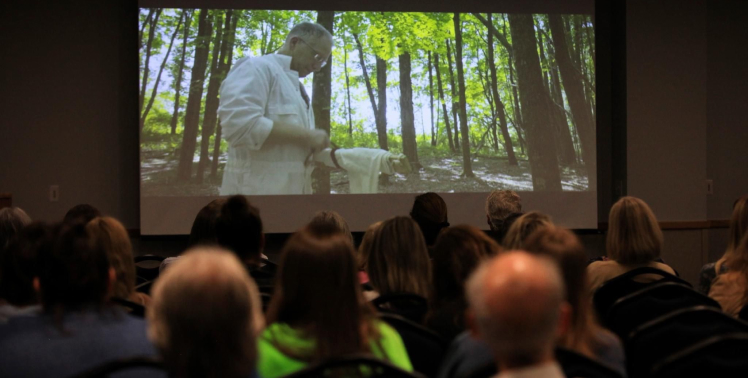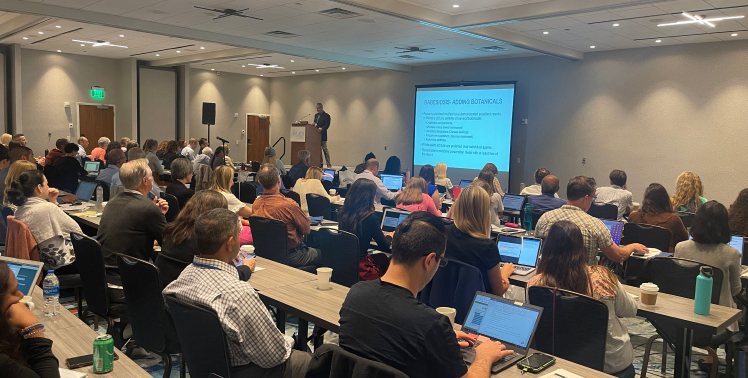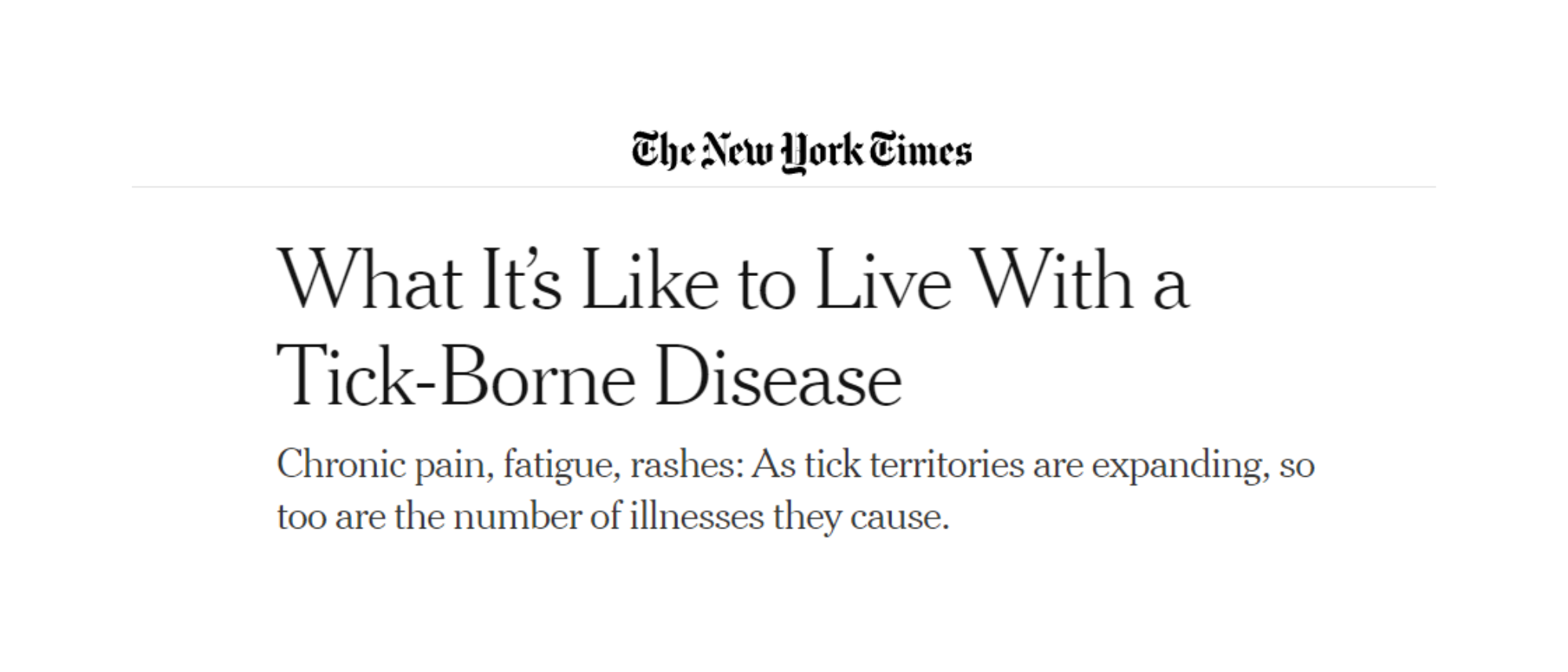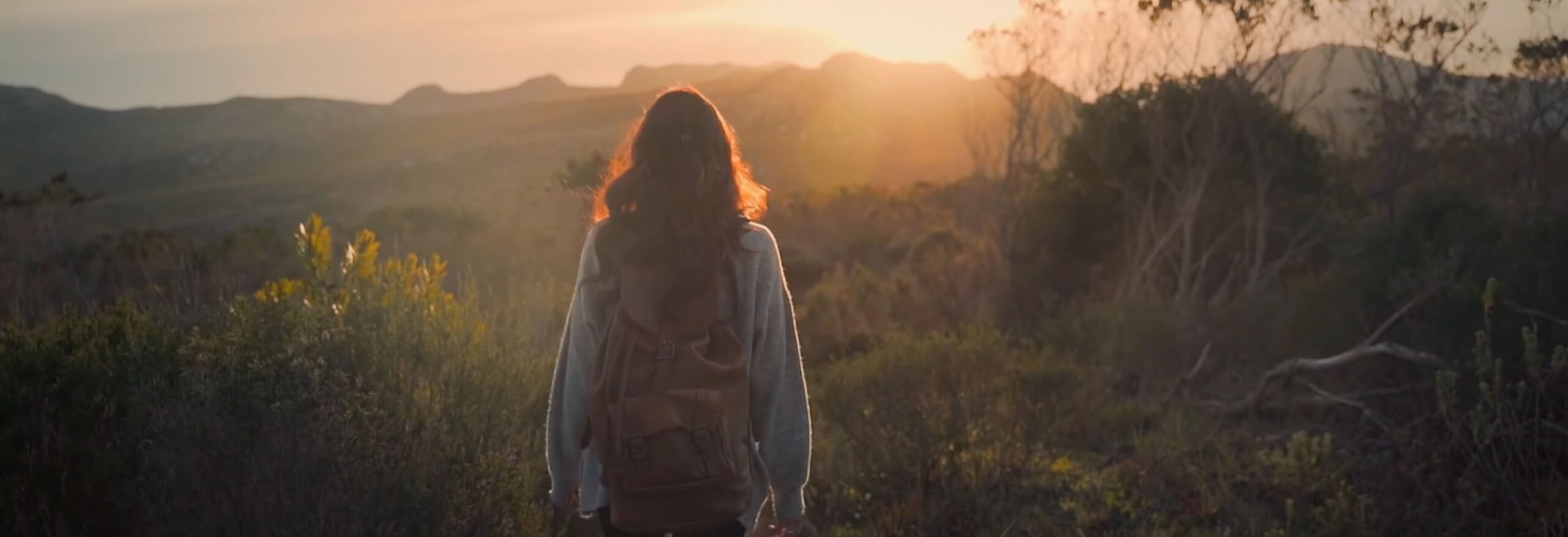

Welcome to Project Lyme
Our mission is to eradicate the epidemic of tick-borne diseases through awareness and education, support of cutting-edge science, and advocacy for solutions to end the suffering.



What We Do
Educate the Public
Project Lyme offers extensive programming to educate patients, doctors, and the public about tick-borne diseases.
What We Do
Researching for a Cure
Project Lyme is a proud partner with Bay Area Lyme Foundation, having granted almost $1,700,000 to 17 different research projects focused on developing better diagnostic methods and therapeutics.
What We Do
Advocating For Solutions
Lyme disease is historically underfunded compared to other infectious diseases. To combat this disparity Project Lyme advocates for increased federal funding for Lyme disease.
What We Do
Support the Community
Project Lyme serves as an incubator for patient support groups and story-sharing initiatives.
-

Distributing National Public Service Announcements
Our Lyme is a Thief PSA series aired a total of 19,365 times on 64 different TV stations in 30 states across the country including ABC, CBS, NBC, FOX, PBS, and more!
-

Hosting Engaging In-Person Events
We host events aimed at educating attendees and raising funds. This includes our annual gala in New York City, several gatherings in Chicago, and dozens of virtual webinars. Over the years we have featured well-known scientific experts and had thousands of people in attendance.
-

Lighting Buildings
Project Lyme partners with multiple buildings and national landmarks to educate about tick-borne disease, including The Helmsley Building in NYC, Willis and Hancock Towers in Chicago, as well as Niagara Falls Park Service. They all have lit green to raise awareness and honor patients.
-

Sponsoring Powerful Films
Cinema can change the hearts and minds of the masses. We have supported numerous films, including The Quiet Epidemic, to help shift the publics perception of tick-borne disease.
-

Supporting Scientific Conferences
Educating doctors is one of the best things we can do to directly improve patient care. Project Lyme sponsors scientific conferences around the country to increase doctor education.
-

Engaging With Media
Members of Project Lyme have been featured in numerous publications over the years including the New York Times, NBC, USA Today, and more!
-
Tim Haystead, Ph.D., Duke University
is working to develop novel small molecule inhibitors that target the Borrelia burgdorferi’s proteins and eliminate the bacteria. By attaching fluorescent chemical compounds called fluorophores to the inhibitor, scientists can also use them as a diagnostic.
-
Geetha Parthasarathy, Ph.D., Tulane University
is furthering her 2022 research evaluating fibroblast growth factor receptor (FGFR) inhibitors as a therapeutic. This is our second time providing funds for this project.
-
Sapient
is working to develop a chronic Lyme disease molecule marker.
-
Emir Hodzic, PhD, UC Davis & Duke University
is evaluating the efficacy of tethered inhibitors of HtpG for eliminating Borrelia burgdorferi infection in a mouse model.
-
Artem Rogovskyy, DVM, Ph.D., and Dzmitry Kurouski, DVM, Ph.D., Texas A&M University
are validating the Raman spectroscopy-based approach for the diagnosis of Lyme disease. This is our second time providing funds to this project.
-
Monica Embers, Ph.D, Tulane University
is analyzing human tissue specimens for Borrelia burgdorferi.
-
Geetha Parthasarathy, Ph.D., Tulane University
is assessing the fibroblast growth factor system in human biological fluids as novel biomarkers of Lyme disease.
-
Kerry Clark, PhD, University of North Florida
is searching for tick-borne pathogens in Rocky Mountain Wood ticks in the Bitterroot Mountains of Western Montana.
-
Artem Rogovskyy, DVM, PhD, DACVM, Texas A&M University
is working to develop a better diagnostic for Lyme disease by exploring the Raman spectroscopy-based approach for the diagnosis of Lyme disease.
-
Janakiram Seshu, PhD, University of Texas at San Antonio
is limiting or eliminating the survival and transmission of Lyme disease pathogen between ticks and reservoir hosts.
-
Flightpath Biosciences, Inc.
is studying clinical biomarkers for Persistent Lyme Disease.
-
William Robinson, MD, PhD, Stanford University
is studying the molecular mechanisms of autoimmune diseases and developing therapeutics.
-
Brian R. Crane, PhD, Cornell University
is identifying antimicrobial treatment for Lyme.
-
Yuko Nakajima, PhD, Brandeis University
is blocking immune evasion by Borrelia burgdorferi and other pathogens.
-
Geetha Parthasarathy, PhD, Tulane University
is developing novel therapeutics for Lyme neuroborreliosis.
-
Michal Caspi Tal, PhD, Stanford University
is determining if a protein marker prevents the immune system from killing Borrelia burgdorferi and screen compounds that may be able to block this interaction.
-
Yong Zhou, PhD, Institute for Systems Biology
is exploring the host response during acute and prolonged exposure to Borrelia burgdoferi.
-
Founding Center For Lyme Action
We have granted a total of $225,000 since 2019 to establish and run the only bipartisan 501 c4 non-profit organization in the country dedicated to growing federal funding for Lyme disease.
-
Volunteering On The Front Lines
Our patient and advocate community is vast and dedicated to the cause. During legislative events, we organize patient representatives to speak directly with legislators.
-
Seeing Federal Funding Results
Since 2019, there has been a total increase of $282 million in additional federal dollars available for tick-borne disease research.
-
Meet-Ups
One of the best avenues of support for Lyme patients is to connect personally with other patients. Mothers Against Lyme hosts Meet-Ups twice a month.
-
Story Sharing
Lyme disease impacts people of all ages, genders, and backgrounds. Through our unique, intimate, and informative social media campaigns, we aim to share the full range of ways in which Lyme disease impacts lives.
-
By The Numbers
Across our programs, Project Lyme has offered hundreds of meet-ups and served thousands of patients in need.
What People Are Saying
Working Towards Our Goal
Project Lyme stands at the forefront of education, research, and advocacy, championing the cause for patients by offering essential resources and actively collaborating with organizations. Together, we strive to ensure that patients can access required care.
Offering Patients Support
Meet-ups are an invaluable resource providing connection, support, inspiration, hope, and guidance to mothers caring for children with Lyme Disease.
Checking For Lyme
A clinical diagnosis is important because of the unreliability of current tests. That is why I partnered with Project Lyme to digitize my symptom questionnaire and help you understand your likelihood of disease. Join the thousands of people who have checked their symptoms by clicking the link below.

